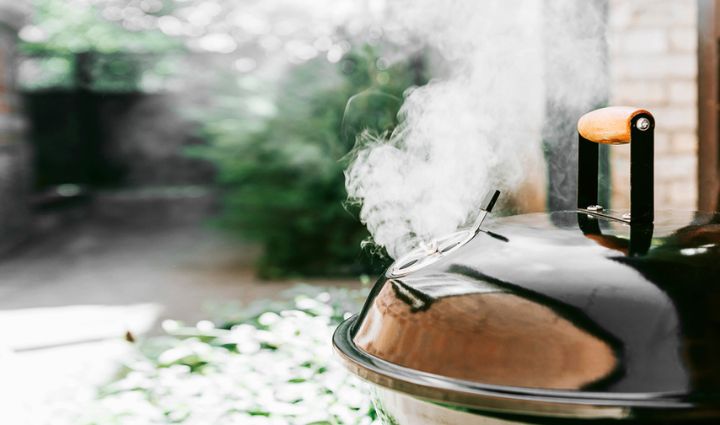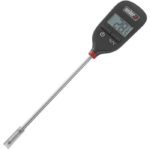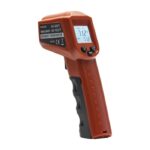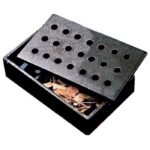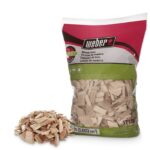When you’re first learning to smoke meat, it’s easy to hit a few bumps in the road—whether it’s with timing, temperature, or wood choice. But don’t worry—these beginner mistakes are all part of the learning process and are easily avoidable once you know what to look out for.
From timing to temperature and choosing the right wood chips, there are a handful of common errors that beginner smokers might encounter. It can be discouraging to spend hours carefully tending an expensive cut of meat only to have it taste wrong, but don’t panic—mistakes are a normal part of the process when you’re learning to smoke meat, and most of them are easy to avoid once you know what to look for.
In this guide, we’ll walk through 13 common mistakes to avoid as a beginner meat smoker, along with our expert advice for how to avoid these issues while you’re learning to smoke meat.
Let’s get grilling!
13 Mistakes Beginner Meat Smokers Make
Even seasoned pitmasters make mistakes from time to time, but knowing what to avoid when you’re learning to smoke meat can save you a lot of trouble as you dive into the world of smoking. Here are 13 common mistakes beginner meat smokers make—and how to steer clear of them.
1. Starting your smoker too late, or not giving yourself enough time
Smoking meat isn’t something you can rush. It takes time to get your smoker properly preheated, and it often takes longer to cook your food than you might expect.
Large cuts of meat can take upwards of 18-20 hours to smoke, so if you’re short on time, steer clear of classic big cuts like brisket or pork shoulder. Instead, go for quicker options like sausages, chicken thighs, or fish.
- SOLUTION: Patience is key! If you tend to get restless, find something else to do nearby so you can keep an eye on your smoker without necessarily watching the clock.
2. Using meat straight from the fridge
Starting with cold meat can result in uneven cooking. And don’t forget the golden rule: never use frozen meat on the smoker!
- SOLUTION: Before smoking, let your meat sit out at room temperature for about an hour (depending on the size of the cut). This allows the meat to cook and absorb the smoke more evenly.
3. Using the wrong coals or wood
Choosing the wrong type of wood can result in over- or under-smoked or oddly flavored meat.
There are two main things to consider when choosing wood chips:
- Size: Should you use chips, chunks, or pellets?
- Type: What smoke flavors go best with your meal?
Choosing the right wood size is easy:
- If you’re using a charcoal grill or dedicated smoker, opt for lump charcoal or wood chunks—briquettes will burn too quickly and won’t get as hot.
- If you’re using a gas grill, chips will be the easiest to manage in your smoker box.
- If you’re using a pellet smoker, you’ll need wood pellets.
Choosing the right wood type is a bit more complicated. Stronger flavored woods like mesquite and hickory tend to pair best with heartier cuts like brisket, while milder woods like apple or pecan pair well with lighter meats like chicken or fish. As you’re learning to smoke meat, experiment with different woods to get a feel for which flavors you like best. Get started with our guide to suggested wood pairings.
- SOLUTION: Choose the wood size that’s most compatible with your smoker setup and experiment with different wood types and flavors to find what you like best. Stick with quality dry hardwoods like oak, hickory, pecan, or fruitwoods like apple or cherry—softer or sappy woods (like pine or cedar) can ruin both your meat and your smoker.
Shop for wood chips and chunks
4. Trimming too much fat
Many large cuts destined for smoking are enveloped in a thick layer of fat. Much of this fat can (and should) be trimmed away, but the fat cap also serves an important purpose: it helps insulate the meat and slow down the cooking process so the connective tissues have more time to break down, which is essential for achieving that melt-in-your-mouth texture. If you trim off too much, you risk losing out on flavor and tenderness.
- SOLUTION: Leave about ¼” of fat cap on larger cuts like brisket. Any more and the smoke won’t penetrate as well, but if you trim it thinner than ¼”, you’ll lose out on delicious flavor.
5. Producing bad quality smoke (or too much smoke)
When you’re a beginner smoker, you may think that more smoke means more delicious smoky flavor. But that’s not the case—too much smoke actually can overpower the flavor of your meat and leave a bitter, acrid taste. Smoke should enhance the flavor profile, never dominate it.
The wrong kind of smoke can also negatively impact the flavor of your food. You want thin, clear-blue smoke in wisps—not thick plumes of white or black smoke.
- SOLUTION: If you’re seeing thick plumes of white or black smoke, make sure your air vents and dampers aren’t clogged. If your smoker isn’t producing good airflow, creosote can build up and settle on your meat. If your vents or dampers aren’t clogged and you’re still producing too much smoke (or the wrong kind of smoke), adjust your ventilation—open the vents to increase airflow and produce more heat, or close them to reduce airflow and cool down your smoking chamber.
6. Peeking too often
It’s tempting to lift the lid and check on your meat—we get it. But you lose valuable heat and smoke each time you open the lid, and this can extend your cooking time. Instead, rely on a thermometer to monitor your meat’s internal temperature so you don’t have to open it up to check its progress.
- SOLUTION: Only open the lid when absolutely necessary, like to apply a mop, spritz, or tend the coals.
Shop for grill thermometers:
7. Not resting your meat
After hours of smelling the delicious scent of wood smoke, waiting even just a few minutes longer to sample your perfectly smoked feast can feel like torture. But resting is a key step in the smoking process, and skipping it is a one-way ticket to disappointment.
Resting allows the juices to redistribute throughout the meat, keeping it moist and melt-in-your-mouth tender. Depending on the cut, you might need to rest your meat for several hours—especially for large cuts like brisket or pork shoulder—so be sure to factor this into your total cooking time. Trust us, the extra time will make all the difference.
- SOLUTION: Don’t skip the resting stage, no matter how hungry or tempted you are. How long you need to rest your food depends on what you’re smoking—it could be as short as 10 minutes (for chicken thighs and sausages, for example), or as long as a couple hours (for brisket or pork shoulder).
8. Choosing the wrong cut of meat
If you’re investing your time and effort into smoking, you want to start with a high-quality cut of meat to give yourself the best possible chance of creating something irresistible. This is the time to splurge on a nice cut from your local butcher, not the discounted, about-to-expire meats from the grocery store.
You also want something with a bit of fat. Lean meats can dry out and get tough, but meats with higher fat content will slowly melt as they smoke.
- SOLUTION: Invest in high-quality cuts of meat with a good fat content.
9. Your grill is too hot or too cold
Smoking meat requires steady, low heat. If your grill or smoker is too hot, your meat may turn out tough and dry. But if the temp is too low, it can stretch out your cooking time unnecessarily.
- SOLUTION: Aim for a steady temperature between 225°F and 250°F. Don’t open your lid unless you need to, and invest in a reliable thermometer to keep a close watch on your heat.
10. Panicking when you hit the stall
The “stall” occurs whenever you smoke larger cuts like brisket or pork shoulder. It happens when moisture evaporating from the meat cools it down, causing the internal temperature to plateau, sometimes for hours. It’s a normal part of the smoking process, and with time the temperature will start to rise again, but for beginner meat smokers, waiting to get through the stall can feel like an age.
- SOLUTION: Resist the urge to crank up the heat—just be patient.
11. Relying on your built-in thermometer
Built-in thermometers typically measure the temperature at the top of the cook box, not at the grate level where your meat is cooking. This can lead to over- or under-heating your grill (see mistake #9).
- SOLUTION: Resist the urge to crank up the heat—just be patient.
12. Ignoring ventilation
Ventilation controls the amount of oxygen your fire receives and is crucial for controlling both the temperature and smoke levels in your grill or smoker. Your air vents (or dampers) regulate the flow of oxygen, which affects how much smoke is produced and how hot your fire burns, so make sure they aren’t clogged before you start a smoke. If you’re embarking on a longer smoke, check them throughout the cooking process in case they get clogged mid-smoke.
- SOLUTION: If your smoke is too low, open the vents to let in more oxygen. If it’s too high, close them to slow the burn.
13. Relying entirely on cook times
Cook times are just guidelines. Many factors—like outdoor temperature and meat size—affect cooking time. If you stick to the letter of your recipe law, you run the risk of over- or under-smoking your meat.
- SOLUTION: Instead of relying strictly on cook times, use a digital thermometer so you know exactly when your meat is perfectly done.
Mastering the Basics of Smoking Meat
Mastering the art of smoking takes patience, practice, and a willingness to learn from your mistakes. As a beginner smoker learning to smoke meat, remember that every cooking session is a step toward refining your technique and discovering what works best for you and your equipment. With time, you’ll develop a feel for the right temperatures, your favorite wood choices, and how long to cook to bring out the best flavors and get that silky melt-in-your-mouth result.

